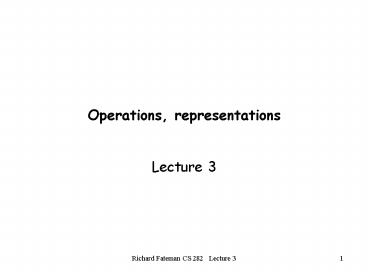Operations, representations - PowerPoint PPT Presentation
1 / 20
Title:
Operations, representations
Description:
Recall that we can compute with any finitely representable objects, at least in principle ... Shows the tendency to obfuscate... What Rings do we use, and what is y? ... – PowerPoint PPT presentation
Number of Views:57
Avg rating:3.0/5.0
Title: Operations, representations
1
Operations, representations
- Lecture 3
2
Recall that we can compute with any finitely
representable objects, at least in principle
- Objects from any algebraic system, and even some
ad-hoc mixtures - With any algorithms
- All steps specified precisely
- Terminating
- Some processes are not-necessarily terminating.
E.g. Lhôpitals rule use termination
heuristics time/space limits, losing some
credibility for results ?
3
The Usual Operations
- Integer and Rational
- Ring and Field operations - exact quotient,
remainder - GCD, factoring of integers
- Approximation via root-finding
- Polynomial operations
- Ring, Field, GCD, factor
- Truncated power series
- Solution of polynomial systems
- Matrix operations (add determinant, resultant,
eigenvalues, etc.)
4
More Operations
- Sorting (e.g. of monomials)
- Union (collections of objects)
- Tests for zero
- Extraction of parts (polynomial degree, constant
coefficient, leading coefficient) - Conversion to different forms (expand, express
algebraic function in a minimal extension,
simplify )
5
Yet More Operations
- Differentiate
- Integrate
- Limit
- Prove
- Find region in which (in)equalities hold
- Confirm (as steps in a proof)
6
Yet More Operations
- Plot
plot3d(exp(-x2-y2)x,x,-2,2,y,-1.5,2.5)
7
Yet More Operations
- Typesetting
8
Integer representations, operations
- The ring operations -
- Euclidean Domain quotient remainder, GCD
- UFD factorization
9
Unfortunately computers dont do these operations
directly
- Addition modulo 231-1 is rarely what we
need. - How do we do arbitrary precision integer
arithmetic? (If we could do this, we could build
the rationals, and via intervals or some other
construction, we could make reals)
10
Is it hard to do arbitrary integer (bignum)
arithmetic?
- In spite of your belief that you are familiar
with this subject, there are subtleties. Famous
examples factorization even in long division! - You must choose fast algorithms (moderate size)
or asymptotically optimal algorithms (large
size) whats your target? - You need fast arithmetic to compute billions of
digits of p e.g. GMP or DH Bailey's home page - Arguably, there are sensitive geometric
predicates that require very high precision.
11
Who cares about integer arithmetic?
- You need to be able to compute with all lengths
of numbers to build a computer algebra system
without it your system lies. SMP used floats
e.g. represented 1/3 by 0.3333333..4. - Every Common Lisp has bignum arithmetic built in,
some import GMP.
12
Some ideas just for representing integers
- Integers are sequences of characters, 0..9.
- Integers are sequences of words modulo 109 which
is the largest power of 10 less than 231.
Maple! - Integers are sequences of hexadecimal digits.
- Integers are sequences of 32-bit words storing 16
bits. - Integers are sequences of 32-bit words.
- Integers are sequences of 64-bit double-floats
(with 8 bits wasted). - Sequences are linked lists
- Sequences are vectors
- Sequences are stored in sequential disk locations
- Sign-magnitude representations possible too.
13
Yet more ideas
- Integers are sequences of 64-bit double-floats
(with 8 bits used to position the bits) - e.g. 2-3002300 takes 2 words
- Integers are stored in redundant form ab
- Integers are stored in p-adic form as a sequence
of x mod p, x mod p2,
14
Addition in each of these representations
- The fastest is the p-adic one, since all the
arithmetic can be done without carry, in
parallel. - Not usually used because
- You cant tell for sure if a number is , -
- Parallelism is almost always irrelevant ?
- If you must see the answer converted to decimal,
the conversion is O(n2) - Conversion to decimal may be very common if your
application is a bignum calculator.
15
Multiplication
- Extremely well-studied.
- The usual method takes O(n2),
- Karatsuba style O(n1.585)
- or FFT style O(n log n).
- These will be studied in the context of
multiplying polynomials. - Note that 345 can be mapped to p(x)3x24x5
where p(10) is 345. - Except for the carry, the operation is the
same.
16
Integer Division
- This is too tedious to present in a lecture.
- Techniques for guessing the next big digit
(bigit) of a quotient within 1 are available,
Knuths Art of Computer Programming vol 2 has
details. - For exact division (not divremainder) consider
Newton iteration as an alternative - FFT / fast multiplication helps
17
GCD
- Euclids algorithm for integers is O(n2 log n)
but is hard to beat in practice, though see
analysis of HGCD (Yap) for an O(n log2 n)
algorithm.. - HGCD is portrayed as a winner for polynomials,
but only by complexity analysts who (I suspect,
in this case) assume that certain costs are
constant when they grow exponentially, and/or
subproblems, even small ones, can be done in O(n
log n) time when n2 is faster
18
Reminder A Ring R is Euclidean
If there is a function y
19
Shows the tendency to obfuscate
What Rings do we use, and what is y? For
integers, absolute value y For polynomials in x,
degree in x y
20
Where next?
- We could spend a semester on integer arithmetic,
but this does not accomplish any higher goals of
CAS - We proceed to polynomials, typically with integer
coefficients or finite field coeffs.































